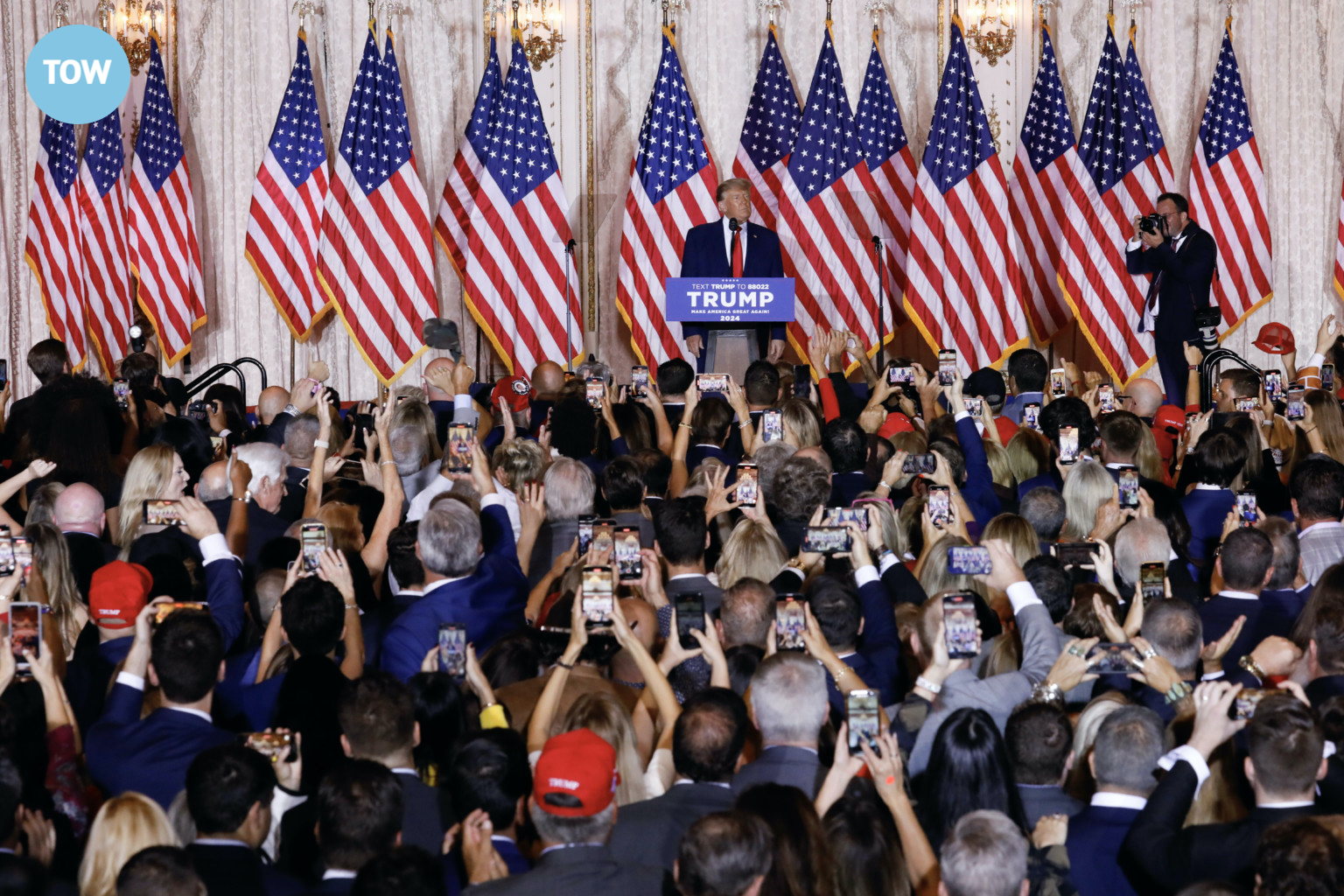Sign up for The Media Today, CJR’s daily newsletter.
Truth Social is barely used by political candidates endorsed by former president Donald Trump, a Tow Center investigation has found, signaling that as Trump launches his 2024 election bid, he is struggling to mount support even on his own right-wing platform.
Just 25 percent of the candidates across Senate, House, and gubernatorial elections who have received Trump’s public backing for elections this year are active users on Truth Social, the Tow Center analysis found. Active use is defined here as having an account and posting at least once in the two weeks before Election Day on November 8.
Not only that—a high proportion of the 219 candidates Trump endorsed for Senate, House, and gubernatorial races did not even appear to have an account on Truth Social, let alone post actively, with 68 percent appearing not to have opened an account. Others who had registered accounts had not posted in months. This investigation used Truth Social’s search function to determine whether politicians had active accounts.
The meager activity by even right-wing political candidates on Truth Social, owned by Trump Media & Technology Group (TMTG), could spell trouble for Trump’s reelection bid. Moreover, it compounds the plethora of problems that have dogged the platform since it launched in February this year—difficulty attracting users, advertisers, and employees, according to a Reuters investigation, and trouble with hosting software. The company is accused of having a lax attitude toward tackling disinformation and extremist content that violates its own content moderation rules, with Google notifying TMTG in August of “several violations of standard policies” to be addressed before the app was added to Google’s Play Store. TMTG is also facing two federal investigations into funding irregularities that imperil its future.
“It’s not particularly surprising to me that lots of candidates that have been endorsed by Trump aren’t on the platform,” said Samuel Woolley, project director for propaganda research at the Center for Media Engagement of the University of Texas at Austin. “For two reasons: first, they would be massively overshadowed by Donald Trump, and second, it’s not likely they’ll be able to reach either the larger public or the media with their messages.”
Trump, who announced his candidacy for president on Tuesday, has made around 285 endorsements this election cycle, according to nonpartisan election-monitoring site Ballotpedia. Political candidate endorsements are often made because politicians “want to move their party in a direction,” Geoff Pallay, Ballotpedia’s editor in chief, told the Tow Center. “Within both major political parties in the United States, an endorsement is a really powerful way to signal who you think is going to shape the direction of the party.”
Of the political candidates endorsed by Trump this year, those running for US Senate were most likely to be active, with 36 percent of the twenty-five endorsed hopefuls active users, such as J.D. Vance in Ohio and Marco Rubio in Florida. The figure for Trump’s gubernatorial endorsements was lower, at 28 percent of twenty-five endorsed candidates, such as Kari Lake, who ran for Arizona governor, and Lee Zeldin, who ran for New York governor. The proportion of active Truth Social users was lower again among US House of Representative candidates, at 22 percent of 169 endorsed hopefuls, according to a count compiled by Ballotpedia. Active House candidates included Kevin McCarthy in California and Marjorie Taylor Greene in Georgia.1Trump claims to have endorsed 330 candidates, but Ballotpedia estimates the endorsements at 285. This investigation focuses on Senate, House, and gubernatorial endorsements only. The tally here for Trump-endorsed candidates excludes Sean Parnell, who withdrew from a Senate race in Pennsylvania; Jackie Walorski, who passed away in a car collision in August 2022; and Steve Carra, who ended his congressional campaign to run in a local race. It includes, for gubernatorial endorsements, three candidates who lost their primaries and one whose election is in 2023.
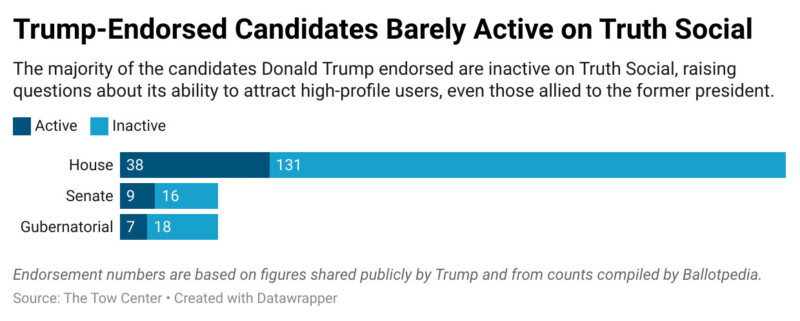
Trump-endorsed candidates are barely active on Truth Social.
“Many of these candidates are campaigning in purple states, so they need to get the independent vote,” Woolley added, “and the fact of the matter is, centrist Republicans and moderates are not on Truth Social.”
The usage from active accounts was often simply a duplication of political messaging originating elsewhere. Lake’s official accounts, for instance, posted a get-out-the-vote message on Truth Social eight minutes after the exact same post on Twitter.
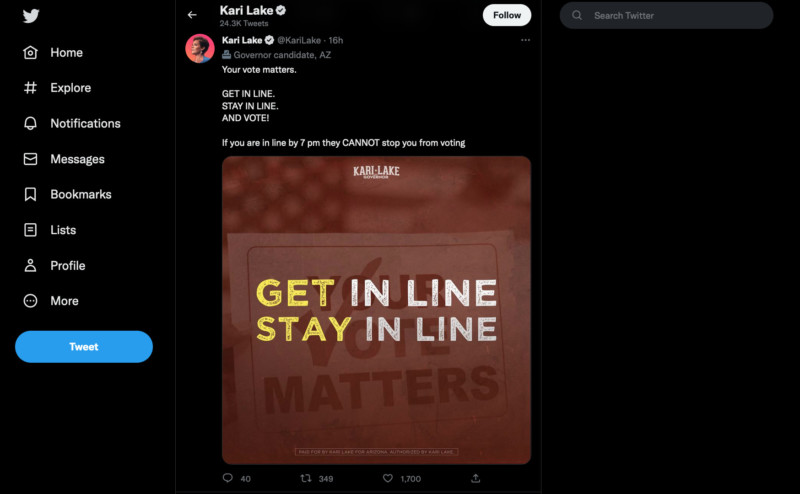
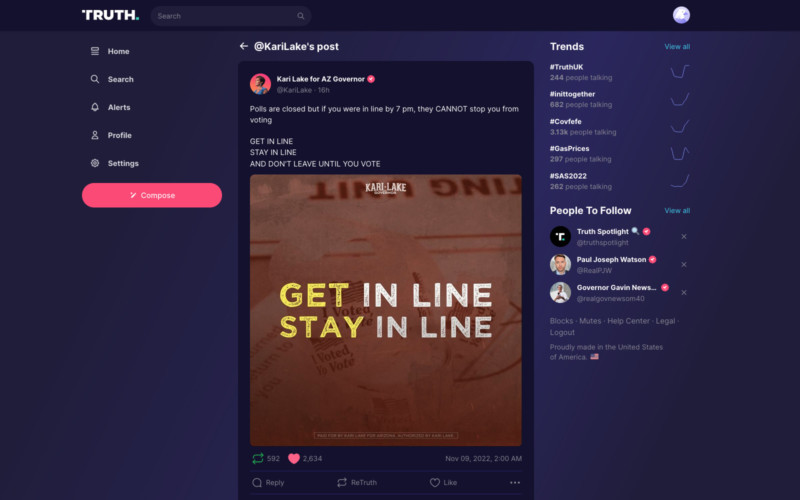
Posts from Kari Lake’s official accounts appeared to be duplicated on Truth Social eight minutes after an identical Twitter post. Image: Tow Center
The low usage, however, does not mean Truth Social is an insignificant platform. It has been a hub for fomenting far-right narratives in the run-up to the elections and the key to Trump’s communications after his suspension from Twitter, and there are fears it will be a crucial staging ground for contesting the 2022 midterms and 2024 presidential elections.
Election denial, with a side of cheeseburgers
Truth Social was launched in the wake of Trump’s permanent suspension from mainstream social media platforms like Twitter and Facebook in January 2021, with Twitter citing “the risk of further incitement of violence” following his inflammatory rhetoric during the January 6 Capitol insurrection.
Three weeks after the riot, in late January, the former president held discussions over cheeseburgers and ice cream at Mar-a-Lago, the Washington Post reported. On the agenda? Building Trump a media company that could rival, and eventually bypass, the existing social media infrastructure, which Trump and his allies regarded as liberally slanted. On February 8, 2021, Trump Media incorporated in Delaware.
Truth Social, when announced in October 2021, was pitched as a platform jettisoning the content moderation model of existing mainstream platforms, forgoing curation algorithms and embracing “free speech.” It sits in a crowded field of right-wing alt-platforms, alongside Gab, Parler, Rumble, and others. “The thing that makes it unique is: Trump is on it,” said Megan Brown, senior research engineer at New York University’s Center for Social Media and Politics.
The intention was to merge TMTG with a special-purpose acquisition company (or spac), a fundraising alternative to an initial public offering (IPO), called Digital World Acquisition Corp. (DWAC). The Wall Street Journal reported the deal would value the venture at $875 million including debt.
Truth Social has sought to expand rapidly, setting growth targets of 56 million users by 2024 and 81 million by 2026, Axios reported. But it ran into trouble with two federal investigations—including an ongoing SEC investigation into whether TMTG and DWAC illegally coordinated before going public—which the New York Times reports jeopardizes roughly $1.3 billion in funding. (State documents showed Trump was removed as TMTG director on June 8, meaning he avoided subpoenas from federal authorities.)
That even Trump’s favored candidates largely seem to have shunned the platform questions the platform’s future viability. According to SEC filings from DWAC, “if President Trump fails to attract and retain the public’s interest or the services provided by TruthSocial…it could result in a write-down of TMTG’s capitalized development costs.” TMTG did not reply to a request for a comment on the findings.
A failure to attract Trump-aligned politicians, however, does not mean Truth Social is insignificant. Despite sluggish uptake, the platform is a growing conservative force, boasting a unique selling point over rival alt-platforms of having Trump as its power user. It had 1.7 million unique visitors in the US in September, according to the New York Times, citing Similarweb, a company tracking online traffic, and it was approved for the Android app store in October this year. (It became available via Apple’s store in February. The internal criteria for such decisions by Apple and Google owner Alphabet are unknown.)
Megaphone to the world
Even with its troubles attracting talent, Truth Social has a number of key functions in the US information landscape.
First, it has become Trump’s megaphone to the world. His “truths” (a carbon copy of Twitter “tweets”) are often pasted to other platforms or reported on by media organizations, ensuring that his messages still spread. According to DWAC SEC filings, “President Trump is generally obligated to make any social media post on Truth Social and may not make the same post on another social media site for 6 hours,” barring political posts. While Trump’s 4.55 million followers are dwarfed by the almost 89 million he had on Twitter before suspension, it’s still an effective means for the former president’s communications, “an amplification mechanism or megaphone for Trump,” Woolley said.
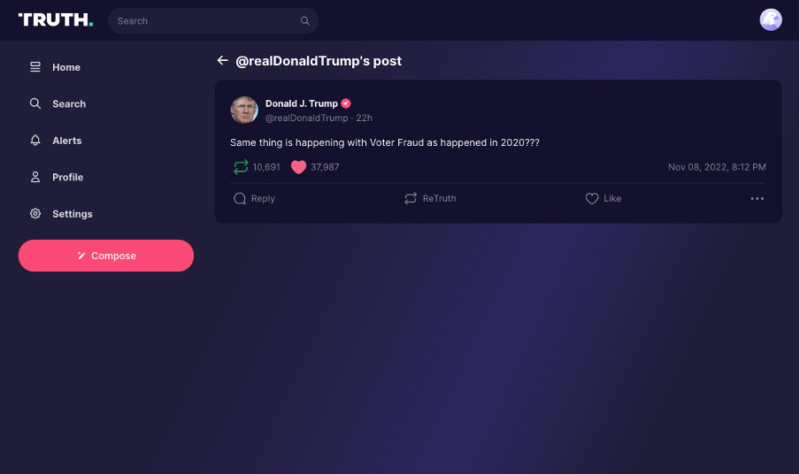
Trump uses the platform in the same way he used Twitter before January 2021: to post both fleeting thoughts and strategic messages seeking to undo, and overturn, Republican failures at the ballot box. Image: Tow Center
Second, Truth Social allows Trump to communicate with his base. It’s a forum for sharing video clips of speeches, endorsements announcements, and get-out-the-vote messages. It’s also become the hub of Trump’s persistent, and baseless, questioning of American voting integrity, preparing the ground for contesting lost free and fair elections. On Election Day, November 8, Trump wrote: “Same thing is happening with Voter Fraud as happened in 2020???”
Third, Truth Social is now a factory farm for extremist far-right narratives—theories, lines of attack, or plans for action that originate on the platform have jumped off, both onto other platforms and into real-world action. “Platforms like Truth [Social], Gab, and Parler are oftentimes incubators for certain types of communication,” Woolley said. “They’re also incubators for memes and virality—and by proxy for disinformation, propaganda, other forms of politicking—so if a given message takes there, people like it and jibe with it, it’s possible that it spreads to the broader ecosystem.”
This is compounded by the fact the platform is a parallel right-wing media universe. None of the US papers of record are active on Truth Social. Media accounts with the most reach are those known to post extremist and misleading information, such as Breitbart News (1.1 million followers), Newsmax (1.7 million), the Epoch Times (860,000), and the Washington Times (240,000), alongside conservative news influencers like Fox’s Sean Hannity (1.4 million) and Maria Bartiromo (1 million).
Increasingly, extremist content is causing real-world impact—reporting from NBC News, for instance, traced how a Truth Social meme about “ballot mules,” a conspiracy theory claiming Democrats were stuffing ballots, led to people watching ballot drops in Arizona while wearing military fatigues—in ways that have raised concerns about voter intimidation and suppression. “The fact these election conspiracies and misinformation around the elections can foment on these platforms is really concerning,” Brown, of NYU, said.
How did we get to the point where election denial was a legitimate position for political candidates? It’s the result of the mainstreaming of extremist content that Truth Social and other alt-platforms represent, said Elizabeth Yates, senior researcher for anti-Semitism at Human Rights First. Beforehand, radicals would need to seek out fringe websites; now they are found on the top charts of major app stores. One impact for Yates is that “the conspiracies associated with [QAnon] have definitely penetrated mainstream dialogue,” she said. “You see this with the idea of ‘groomers,’ a talking point among certain mainstream politicians, or this idea of a ‘cabal’ of people who orchestrated a win for Joe Biden [in 2020], even though that was totally illegitimate.”
Justin Hendrix, chief executive and editor at the nonprofit Tech Policy Press, which covers technology and democracy, said app stores’ gatekeepers, like Apple and Alphabet, need to face more scrutiny for effectively mainstreaming apps that allow extremist content to circulate. “I am particularly interested in those companies being much more forthright and honest and transparent about how they’re making those [approval] assessments and sharing their homework,” Hendrix said. “Because right now, we don’t know who makes the final call.”
The concern is of this real-world impact spilling over into political violence. Election deniers “have been violent, and will be again,” Yates said.
Future in peril?
With two federal investigations ongoing, imperiling roughly $1.3 billion in funding, the future of Truth Social is uncertain. Reports suggest it currently has enough money to operate to spring 2023 but no further. And despite Trump’s arrangement with the platform to post with a six-hour window of exclusivity, there has been speculation after Elon Musk’s acquisition of Twitter over whether the former president will return to the more mainstream platform—killing his smaller project in the process.
Yet even without Trump migrating back to Twitter, it’s make or break for Truth Social. In terms of revenue, there may also be an inherent clash between drawing down commercial revenues and a commitment to unmoderated speech on the platform, which attracts extremist content. “Advertisers might not want to have their ads next to objectionable content,” Brown said.
It’s worth questioning whether there’s a big enough market in general for a platform dedicated to free-speech absolutists, Hendrix said. “The big question is, who’s going to pay for it? Advertisers? Individuals?” he said. “There’s a real question about whether the thing is commercially viable. I suspect the answer is no.”
Christine Flammia contributed reporting.
Has America ever needed a media defender more than now? Help us by joining CJR today.




